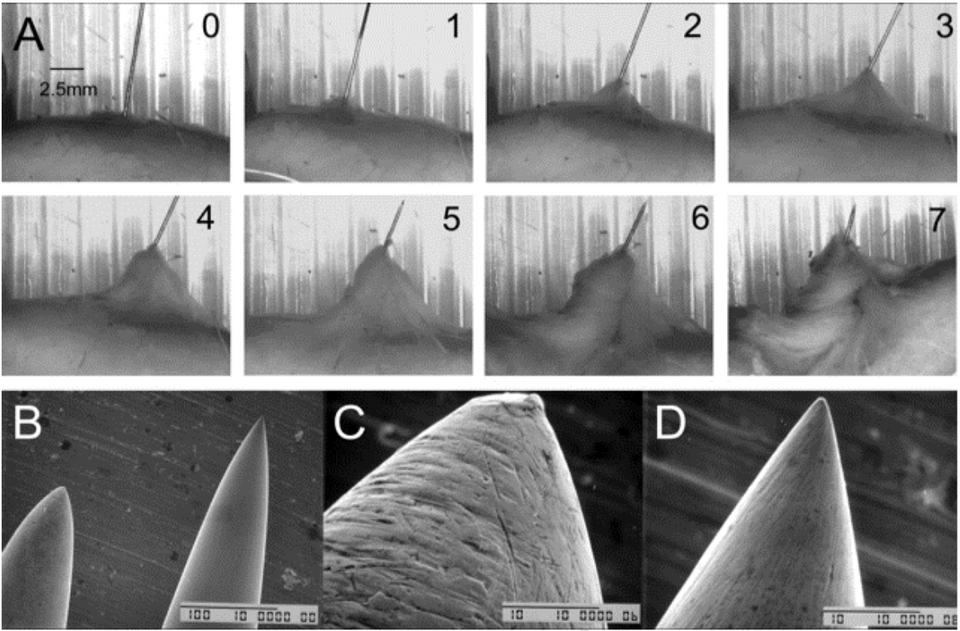🦀 PT Crab Issue 99 - Dry Needling, Hokey Pokey? Nopey Nopey.

This week we’re doing a whole big thing on dry needling. I’ve been asked about it a bunch and decided that it is time to settle it now and for now. Because it’s not once and for all, that’s how research works. But now and for now, here’s what we know.
P.S. if DN isn’t allowed in your state, isn’t something you do, or you’re an inpatient therapist (ick, poop), sorry! But more coming for you in future.
With that, let’s dive in!
Plantar Fasciitis? Not bad.
The Gist - This systematic review and meta-analysis published in the journal Pain Medicine in March 2021 dug around for RCTs that gave DN to trigger points associated with plantar heel pain. They checked outcomes related to pain and disability. 6 trials were eligible, showing low-quality evidence that DN reduces pain in the short term (-1.77 points on 0-10 scale, with 0.8 being the MCID there). There was moderate quality evidence that it improved pain (-1.77) and disability in the long term as compared to control groups.
Those control groups were all either “sham dry needling, no intervention, or another intervention such as manual therapy or corticosteroid injections.”
I want more details. Get ‘em here.
Tension, Cervicogenic, Migraine Headaches? Pretty Good.
The Gist - This systematic review and meta-analysis from PTJ in February 2021 looked at 11 RCTs in the qualitative synthesis and 9 in the meta-analysis for reducing pain from these types of headaches when compared to “physical therapy interventions, pharmacological interventions, injections with different substances, and sham or control groups.” The researchers found very low quality evidence that dry needling is not better at improving headache pain the short term in people with tension-type and mixed headaches. It “provided significantly greater improvement in related disability in the short term in patients with TTH and CHG”.
“The synthesis of results showed that dry needling could significantly improve headache frequency, health-related quality of life, trigger point tenderness, and cervical range of motion in TTH and CGH.”
But this one comes with some caveats. The studies they had to include were largely low quality, heterogenic, and the needling methods they used were sometimes questionable. Still, the authors felt good enough to make a strong conclusion and that works for me. But do your own look through to verify the deets.
I wanna look! Enjoy.
Pain, Spasticity, and Motor Function Post Stroke. Maybe?
The Gist - This paper, also from Pain Medicine in 2020 looked into seven RCTs on dry needling versus other treatments for spasticity and pain. Four studies were UE, three LE. “The meta-analysis found significantly large effect sizes of dry needling for reducing spasticity (SMD: -1.01) and pressure pain sensitivity (SMD 1.21)” at short term follow-up. There was no effect at 4 weeks and no significant effects on motor function were seen.
Like the other studies, the work here was heterogenous and some of the needling technique was questionable. Some of the controls were just that, not comparators, and the results weren’t huge. So, maybe?
Decide for yourself here. Like, here.
Shoulder Pain? Yeah man.
The Gist - This piece from PTJ looked into dry needling for non traumatic shoulder pain and pulled together 6 RCTs to get data from. Overall, there was moderate quality evidence that “dry needling reduces shoulder pain intensity with a small effect (mean difference = −0.49 points).” There was also low quality evidence that it improves disability with a large effect (mean difference = -9.99 points). You know they really did the math because they didn’t just round it up to 10. On the downside, the effects on pain were only short term and (as usual) heterogeneity in the studies reigned.
What we do know from this one is that it probably needs to be applied at least three times to have a real effect, so keep that in your pocket.
I want details! Have them.
DN for Pain? Yes, just pain? Indeed.
The Gist - Now that you’ve looked at DN specifically, let’s look at it generally. Does it treat pain when applied to myofascial trigger points? Yes. According to this PTJ article that grabbed 42 RCTs that compared DN to other treatments or placebo. And just to plop all their results here because they summed it up so efficiently
This meta-analysis found a large effect to decrease pain within 72 hours (standardized mean difference = −0.81), a moderate effect in 1 to 3 weeks (SMD = −0.69), a large effect in 4 to 12 weeks (SMD = −0.85), and a large effect in 13 to 24 weeks (SMD = −0.81). The risk of bias was generally low; however, the heterogeneity of the results downgraded the level of evidence.
Look, you’re going to have to actually read this one to get the details because it’s really big, but it’s chock full of nuts and also useful links to studies, information about specifics, and more. This is a general overview Crab, so that’s all you’re getting from me today, k?
Paper? Sure thing.
Orofacial pain associated with TMJ dysfunction? Probably, yea.
The Gist - I’m not going to go into this one because I know very little about TMJ and, frankly, I’m tired. But what I will tell you is that it outperformed other interventions on short term pain and that 7 trials of (once again) high heterogeneity were assessed. We have low quality evidence and a small effect size here, so check out full details.
I love teeth, can I see? Ummm…. Sure. But like, it’s not about teeth, remember that.
I didn’t go through looking specifically for systematic reviews that showed that DN works. But I have positive publication bias and journals have positive publication bias. There are probably plenty of papers out there showing that DN doesn’t work that haven’t been published and that’s sad. But the data that we do have available for these things is published above. That’s what we know right now. The heterogeneity sucks, I know. We need more standardized protocols in needling research and practice and we need it now. And you yourself (yes, you) need to double-check the effect sizes, techniques, and information from the individual papers to make sure it actually fits your clinical practice. But you do that every week, right? Lol.
Also, there are some legitimate criticisms about the design and structure of dry needling research and about how much legistlative advocacy effort it receives since advocacy time and money are limited resources. I don't have time to go into it today but I want you to know it exists and I'm down to talk about it whenever.
Anyway, that’s all I have this week. Aside from once again thanking you for being a supporter and letting you know that next week is both Issue 100 and the introduction of a brand new thing where you can get paid to recommend the Crab to people. Wouldn’t that be nice? Share something you love, help me, make a bit of dough as long as they subscribe, win win win. Win. Win. WIN.
Anyway, have a great week,
Luke
WAIT! One last thing. I know that I don't normally advertise toward you supporters but I found this cool company you should know about called How to Heal Co. They make shirts about mental health and surviving that come with free therapy sessions. Yes, really. Learn more about them at HowToHealCo.com and see one of their shirts below.

Here’s the bibliography:
- Bynum, R., Garcia, O., Herbst, E., Kossa, M., Liou, K., Cowan, A., & Hilton, C. (2020). Effects of Dry Needling on Spasticity and Range of Motion: A Systematic Review. The American Journal of Occupational Therapy, 75(1), 7501205030p1-7501205030p13. https://doi.org/10.5014/ajot.2021.041798
- Llurda-Almuzara, L., Labata-Lezaun, N., Meca-Rivera, T., Navarro-Santana, M. J., Cleland, J. A., Fernández-de-las-Peñas, C., & Pérez-Bellmunt, A. (2021). Is Dry Needling Effective for the Management of Plantar Heel Pain or Plantar Fasciitis? An Updated Systematic Review and Meta-Analysis. Pain Medicine, 22(7), 1630–1641. https://doi.org/10.1093/pm/pnab114
- Navarro-Santana, M. J., Gómez-Chiguano, G. F., Cleland, J. A., Arias-Buría, J. L., Fernández-de-las-Peñas, C., & Plaza-Manzano, G. (2021). Effects of Trigger Point Dry Needling for Nontraumatic Shoulder Pain of Musculoskeletal Origin: A Systematic Review and Meta-Analysis. Physical Therapy, 101(2), pzaa216. https://doi.org/10.1093/ptj/pzaa216
- Pourahmadi, M., Dommerholt, J., Fernández-de-Las-Peñas, C., Koes, B. W., Mohseni-Bandpei, M. A., Mansournia, M. A., Delavari, S., Keshtkar, A., & Bahramian, M. (2021). Dry Needling for the Treatment of Tension-Type, Cervicogenic, or Migraine Headaches: A Systematic Review and Meta-Analysis. Physical Therapy, 101(5), pzab068. https://doi.org/10.1093/ptj/pzab068
- Sánchez-Infante, J., Navarro-Santana, M. J., Bravo-Sánchez, A., Jiménez-Diaz, F., & Abián-Vicén, J. (2021). Is Dry Needling Applied by Physical Therapists Effective for Pain in Musculoskeletal Conditions? A Systematic Review and Meta-Analysis. Physical Therapy, 101(3), pzab070. https://doi.org/10.1093/ptj/pzab070
- Vier, C., Almeida, M. B. de, Neves, M. L., Santos, A. R. S. dos, & Bracht, M. A. (2019). The effectiveness of dry needling for patients with orofacial pain associated with temporomandibular dysfunction: A systematic review and meta-analysis. Brazilian Journal of Physical Therapy, 23(1), 3–11. https://doi.org/10.1016/j.bjpt.2018.08.008






Comments
Want to leave a comment and discuss this with your fellow PTs? Join PT Crab and get summarized PT research in your inbox, every week.